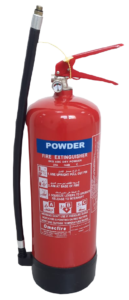What is a Fire Extinguisher & Types of Fire Extinguishers ?
A fire extinguisher is a handheld active fire protection device usually filled with water or chemicals in it, that is used to control small fires, often in emergencies.
To understand fire extinguisher and its use first we need to understand types of fire, the types of fire is called as classes of fire.
Classes of fire:
The classes of fire include following classes, lets understand briefly one after the other.
Class A:
It includes fires caused by flammable solid materials such as wood, clothes, plastic and rubber.
Class B:
It includes fires caused by flammable liquids such as petrol, diesel and paint or oils.
Class C:
It includes fires caused by flammable gases such as methane, propane and hydrogen etc.
Class D:
It includes fires caused by combustible metals such as aluminium, magnesium and potassium etc.
Class F:
It includes fires caused by cooking oils such as olive oil, sunflower oil and butter etc.
Main components of fire extinguisher:
It includes components like canister, extinguishing agent, nozzle and handle.
Canister:
- Canister holds the extinguishing agent.
Extinguishing agent:
- It’s the special substance (like powder or foam) inside the container that puts out the fire.
Nozzle:
- Nozzle is one of the parts of extinguisher where the agent comes out in a spray.
Handle:
- The handle is what you squeeze to activate the extinguisher and release the agent onto the fire.
Now let’s discuss types of fire extinguishers which are available in market.
Also Read : ” Types of Fire Sprinkler Heads “
Types of fire extinguishers:
There are mainly five types of fire extinguishers are available in market. They are:
- Water extinguishers
- Foam extinguishers
- CO2 extinguishers
- Dry powder extinguishers
- Wet chemical extinguishers
Important note: There is no such type of extinguisher which work on all classes of fire.
Now let us understand the types of fire extinguishers on the basis of extinguishing agents.
Water type fire extinguisher:

- Water type fire extinguisher is suitable for class A fires consisting of paper, wood, straw, coal and rubber etc.
- They are noted by red colour.
- Water(H20) has a cooling effect on fire and removes heat element from fire.
Limitations:
- It is unsafe to use on burning fat or oil (class F).
- It is unsafe to use on burning metals and burning liquids.
Foam type fire extinguisher:
- Foam extinguishers are suitable for solid fires as well as for liquid fires.
- This extinguishers noted with cream colour.
- Foam has a cooling effect on fuel, and it creates barrier between flame and heat then it removes heat element from the fire.
Limitations:
- It is unsafe to use on fires involving electrical equipment and flammable metals.
Chemicals used in foam fire extinguisher are:
- AFFF (Aqueous Film Forming Foam)
- FFFP (Film Forming Fluoro Protein)
CO2 type of fire extinguisher:
- This are noted with black colour.
- They are suitable for fires involving burning liquids (class B) and electrical fires, such as large computer equipment fire.
- Co2 extinguisher get very cold during discharge and may cause fingers to freeze.
- The CO2 takes away oxygen element from the fire so the fire will stop.
Limitations:
- It is unsafe to use on combustible materials like papers and clothes etc.
Dry powder fire extinguisher:

- These fire extinguishers are noted by blue colour.
- It is suitable for class A, B, C and fires involving electrical equipment upto 100V. It is called as ABC extinguisher.
- Dry powder extinguisher is the maximum used extinguisher among all the types. Chemicals used in this extinguisher are sodium bicarbonate, sodium chloride, aluminium sulphate, potassium bicarbonate, potassium chloride.
- It can create loss visibility for some time and may create breathing problems.
- It is difficult to clean the residue after the use.
- The dry powder removes heat element from fire, by creating a barrier between fuel and oxygen elements.
Limitations:
- It is unsafe to use on cooking oil and electrical equipment over 1000V.
Wet chemical fire extinguisher:
- This extinguishers noted with yellow colour. It is designed to use on class F fires.
- The wet chemical removes heat from fire cools the burning oil and forms a soap like solution.
Limitations:
- It is unsafe to use on flammable liquids, gas fires and flammable liquids.
How fire extinguishers works?
- Pull the pin and squeeze the handle, and spray the extinguishing agent out through the nozzle onto the fire.
- The agent works in different ways depending on the type on fire extinguisher. It can cool the fire, remove oxygen, or interrupt the chemical reaction that’s fueling the fire.
Maintenance and Training:
Proper maintenance, regular inspections, and refills are vital to ensure fire extinguishers are functional during emergencies. Additionally, individuals should receive training on how to use extinguishers effectively to respond safely in fire emergencies.
Conclusion:
- In short, fire extinguishers are like handy tools that contain special stuff to put out fires.
- They are important for safety and can help prevent small fires from becoming big ones.

